Native Florida Trees (With Pictures) – Identification Guide
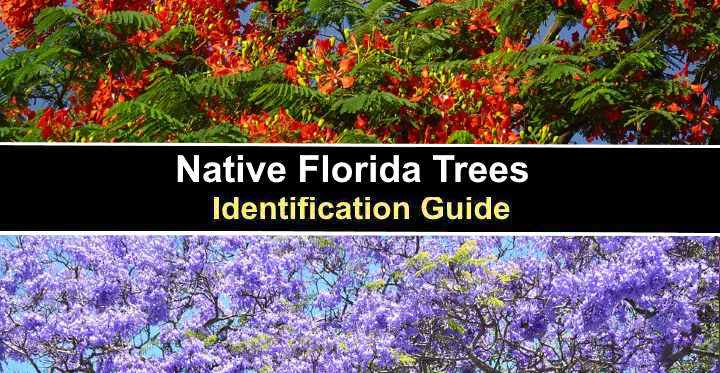
Native Florida trees are hardy trees that thrive in the diverse climate of the Sunshine State. Many species of trees native to Florida include pine trees, oak trees, cypress trees, and a wide range of deciduous trees. Trees that grow well in Florida must tolerate constant sunshine, high humidity, and salty coastal air. In addition, Florida’s climate of mild winters in the south and freezing winter temperatures in the north brings additional challenges.
Not all native Florida trees can thrive throughout the state. For example, the native longleaf pine grows well in Central and Northern Florida but may struggle south of Lake Okeechobee. However, the slash pine and evergreen southern live oak are suitable for growing from Miami to Jacksonville and west to Pensacola.
Are you interested in native trees growing in Florida? If so, please continue reading to learn about the most beautiful trees to grow in the southeastern US.
This article provides information on identifying native trees in Florida. In addition, it includes descriptions and photos of the most popular native trees found throughout the Sunshine State.
Growing Zones for Native Florida Trees
Several factors determine which native trees grow in a Florida landscape. You should consider sun exposure, humidity, soil type, and proximity to the coast. However, Florida’s diverse growing zones mean that some trees suitable for southern regions may not survive cold winters in the north.
Florida’s USDA growing zones range from 8 through 11. Here is a short guide to growing zones for native Florida trees:
Florida USDA Zone 8: Florida’s Panhandle in the northwest along the Gulf coast from Pensacola to almost the Atlantic coast, but not including Jacksonville. Cities include Tallahassee, Panama City, and Pensacola. The minimum winter temperature is 20°F (-6.6°C).
Florida USDA Zone 9: Central Florida from the north around Gainesville to the northern tip of Lake Okeechobee. Zone 9 covers all the central area from the Mexican Gulf to the Atlantic. Cities include Jacksonville, Orlando, and Tampa. The minimum winter temperature is 25°F (-3.8°C).
Florida USDA Zone 10: The tropical area of Florida south of Lake Okeechobee to the southern tip of the state, including Miami, Cape Coral, Naples, Fort Lauderdale, and the Everglades. The minimum winter temperature is 30°F to 35°F (-1.1°C – 1.7°C).
Florida USDA Zone 11: The southernmost point of Florida includes the Florida Keys. The climate is hot and humid with short, mild winters. Minimum winter temperatures are 40°F to 45°F (4.4°C – 7.2°C).
How to Choose Native Trees to Grow in Florida
There are a few things to consider if you want to plant native trees in a Florida landscape. First, think about the growing zone and how much sunshine they require. However, you should also check the tree’s growth rate, mature height, and spread. Lastly, think about how much maintenance it will require.
Native Florida Trees (With Pictures) – Identification Guide
There are over 460 species of native trees and shrubs in Florida that come in various shapes and sizes. We’ll look in detail at how to identify some beautiful pines, oaks, cypress, and flowering trees native to the Sunshine State.
Native Florida Pine Trees
Pine trees are common throughout Florida, with many suited to growing in sandy soils and tolerant of heat, humidity, and coastal sea air. In addition, many evergreen pine trees are ideal for shade trees or adding year-round color to a landscape.
Slash Pine (Pinus elliottii)

Slash pine has long needles and is native to Florida
Among the pine trees native to Florida is the slash pine. This common Florida pine tree is a fast-growing tree with long needle-like leaves, reddish-brown scaly bark, and long slender pine cones. Slash pine trees grow up to 100 ft. (30 m) tall and have a rounded, spreading crown.
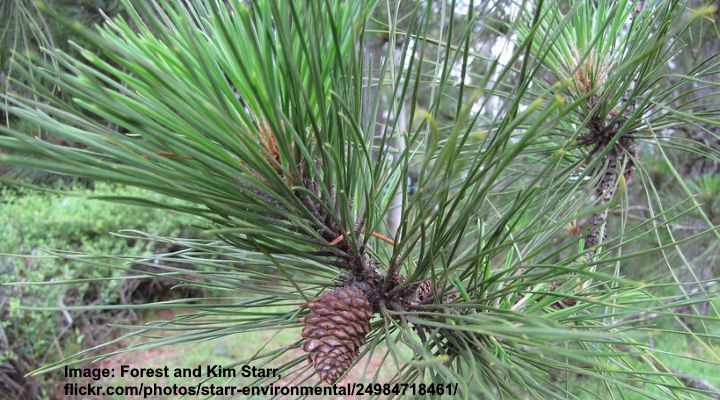
Slash pine needles and a cone
Slash pine trees thrive throughout Florida. They are one of the most common pine species growing from the Panhandle all the way to the Florida Keys. The coniferous evergreen usually grows in swampy ground. Therefore, it also goes by the names southern Florida pine, swamp pine, or yellow slash pine.
The slash pine resembles another native pine tree, the longleaf pine. However, the slash pine has shorter, less glossy needles growing in clusters of two rather than three and its red-brown cones are smaller.
Slash pines are suitable for USDA zones 7 to 11.
Native Florida Tree Identification
Slash pine tree is identified by its needles growing 5” to 11” (13 – 28 cm) and reddish-brown pine cones growing up to 6” (15 cm) long.
Sand Pine Tree (Pinus clausa)
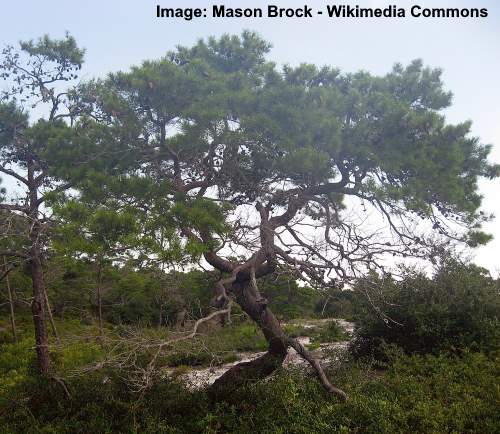
Sand pines grow in most parts of Florida and are identified by their twisted branches
The sand pine tree grows throughout Florida apart from zone 11 and the hottest regions of zone 10. The evergreen sand pine has an irregular or rounded crown, reddish-brown bark, and slender needle-like leaves growing in one pair per fascicle. Sand pines can grow up to 65 ft. (21 m) tall, but usually grow 16–33 ft. (5–10 m).
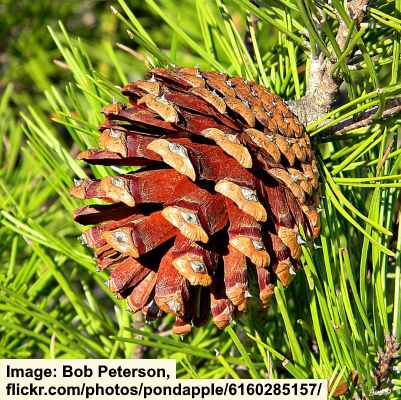
Sand pine cone
The pine needles measure 2” to 4” (5 – 10 cm), and the elliptical-shaped cones are 1.2” to 3.1” (3 – 8 cm) long. Sand pine bark is a grayish-brown color near the base, becoming redder nearer the crown. Many species have tall, erect trunks. However, some pines have crooked trunks with twisted branches.
Sand pines are the most common pine tree in north-central Florida from St. Augustine to Ft. Lauderdale and narrow coastal strips south of Tampa and Naples.
Sand pine trees are suitable for USDA growing zones 7 through 10.
Native Florida Tree Identification
Sand pine trees have cylindrical pale brown or reddish-brown cones and needles that grow in pairs.
Longleaf Pine Tree (Pinus palustris)
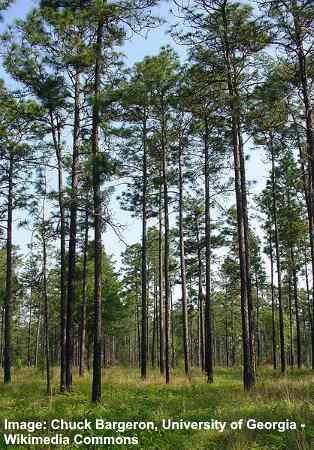
Longleaf pines have long needles and trunks
The longleaf pine is a tall native Florida tree growing throughout Northern Florida. This native Florida pine tree has a tall, straight trunk, rounded crown, and short branches. Identifying features of the longleaf pine tree are its needles growing in groups of three measuring 8” to 18” (20 – 45 cm) long and its lance-shaped cones.
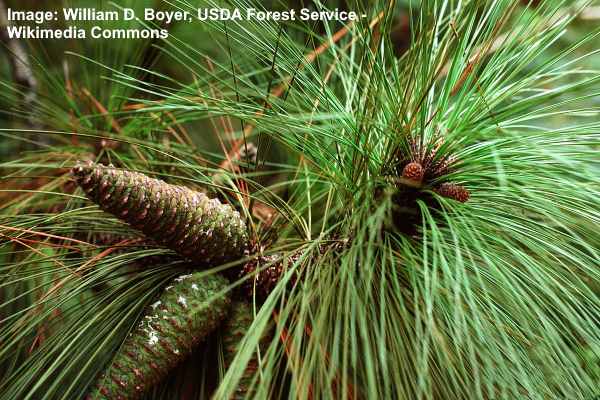
Longleaf pine needles and immature cones
The longleaf pine tree grows up to 150 ft. (48 m) tall and is characterized by its slender, straight trunk. You will find this tall, majestic pine tree growing throughout Northern Florida in zones 8 and 9. Its typical habitation is sandhills, dry sandy uplands, and flatwoods.

A mature cone of longleaf pine
Native Florida Tree Identification
The longleaf pine is identified by its long slender needles and cylindrical reddish-brown cones growing 6” to 10” (15 – 25 cm) long.
Native Florida Cypress Trees
Florida is home to two species of native cypress trees — the pond cypress and the bald cypress. These deciduous conifers are suited to Florida’s landscape because they thrive in swampy conditions but also tolerate some drought.
Pond Cypress (Taxodium ascendens)
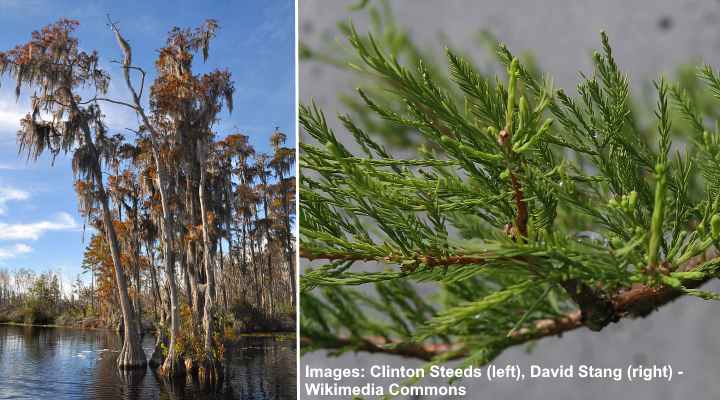
Pond cypress trees and foliage
The pond cypress is an attractive cone-bearing tree (conifer) with a columnar or narrowly conical habit. The medium-sized tree is identified by its grayish bark, soft, bright green needle-like leaves, and horizontally growing branches. Unlike other conifers, the pond cypress drops its leaves in the fall after turning rich orange shades.
Pond cypress trees grow 50 to 60 ft. (15 – 18 m) tall and up to 15 ft. (5 m) wide. You can grow pond cypress conifers as shade trees, especially in poorly drained soils.
Native Florida Tree Identification
The pond cypress tree has a grayish trunk that bulges at the base if it grows in swampy, waterlogged soil. It’s identified by its bright green foliage that turns orange and small ovoid cones that emerge purple and turn brown.
Bald Cypress (Taxodium distichum)
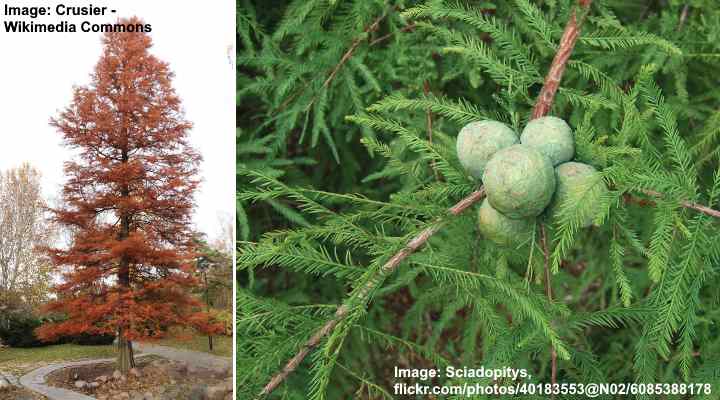
Bald cypress tree, foliage and cones
The bald cypress is a native Florida coniferous tree that grows in marshy, swampy areas throughout the state. Bald cypress trees are distinguished by their upright growth and triangular crown. The deciduous conifer has grayish-brown bark, needle-like green leaves 0.75” (2 cm) long, and small spherical cones.
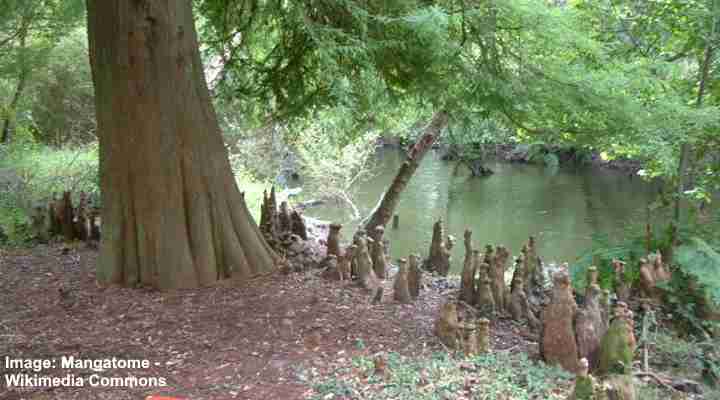
A common feature of bald cypress trees is the roots that grow around the tree and are called “knees”
The bald cypress grows 35 to 120 ft. (10 – 40 m) tall. A unique feature of this conifer is its swollen, knobby base (called knees) that develop when it grows in swamps.
The tall, slender conifer also goes by the names tidewater red cypress, swamp cypress, and gulf cypress.
Native Florida Tree Identification
Identifying features of the bald cypress are its thin grayish-brown bark, green foliage that turns russet-red in the fall, and round greenish cones that turn hard and brown.
Native Florida Oak Trees
Florida is home to several species of native oak trees — some deciduous and others evergreen. In many Central and Northern Florida landscapes, oak trees have a significant environmental role. And a few oaks are suited to Florida’s diverse climate.
Southern Live Oak (Quercus virginiana)
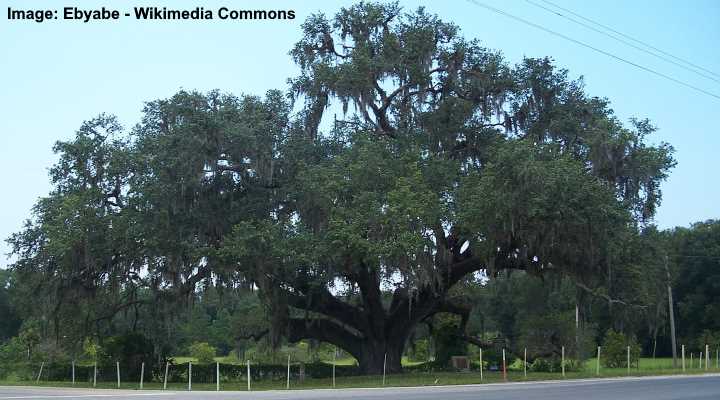
Live oak tree (Quercus virginiana)
The southern live oak is classified as an evergreen oak tree with glossy green oval leathery leaves, thick dark bark, and small oblong dark brown acorns. Southern live oaks have a rounded, spreading crown and gnarled branches. Live oaks in Florida typically grow 66 ft. (20 m) tall and up to 90 ft. (27 m) wide.
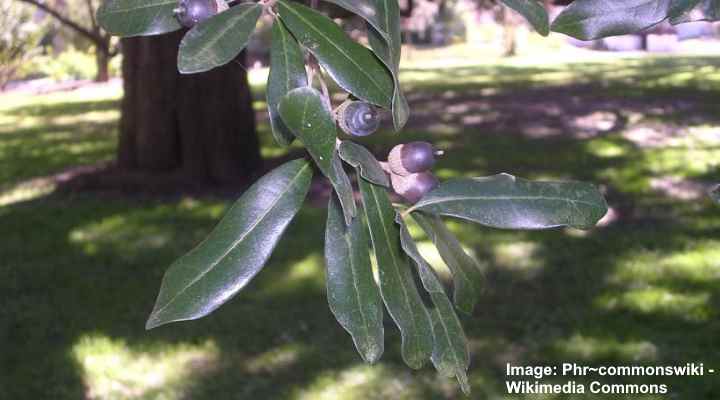
Live oak tree leaves and acorns
Characteristics of the southern live oak tree are its smooth, shiny leaves measuring up to 6” (15 cm) long, small oblong acorns measuring 1” (2.5 cm), and small clusters of finger-like white flowers.
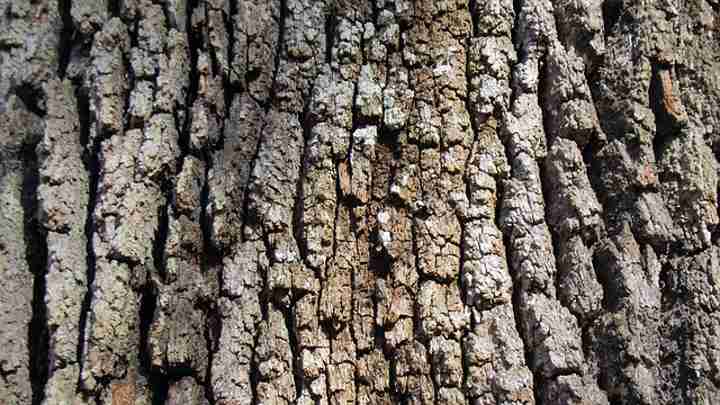
The southern live oak has dark brown bark with a scaly appearance and longitudinal furrows
The southern live oak species is one of Florida’s most common oak trees. It grows in all regions of Florida, from the Panhandle in the north to the Florida Keys in the south.
Native Florida Tree Identification
The southern live oak is identified by horizontally spreading branches, leathery, lanceolate leaves, and dark brown, almost black acorns.
Turkey Oak Tree (Quercus laevis)
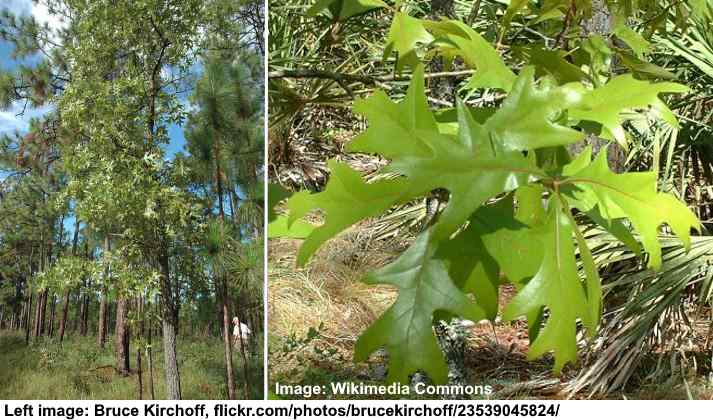
Turkey Oak Tree (Quercus laevis)
The turkey oak tree is a species of red oak tree that commonly grows in the southeastern United States. This small deciduous heat-loving oak tree grows 26 – 33 ft. (8 – 10 m) tall and can have multiple stems giving it a shrubby appearance. You’ll find the oak tree throughout Northern and Central Florida.
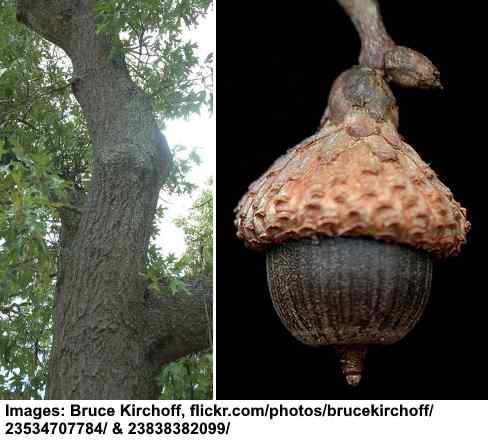
Turkey oak tree bark and acorn
Identifying features of turkey oak tree are its unique leaves, dark acorns, and fall colors. The oak leaves measure 4” to 6.75” (10 – 17 cm) and are pointed and deeply lobed resembling a turkey’s foot. The acorns are greenish when young and become darker as they mature with prickly caps, and the bright green leaves turn red in the fall.
Native Florida Tree Identification
The turkey oak tree is identified by its shrub-like growth and shiny green, three-lobed leaves, and coppery-brown acorns measuring 1” (2.5 cm) long.
Other Native Trees in Florida
Let’s look in detail at other native Florida trees prized for their stunning flowers, attractive foliage, and ability to provide shade on hot, sunny days.
Crape Myrtle Tree (Lagerstroemia indica)
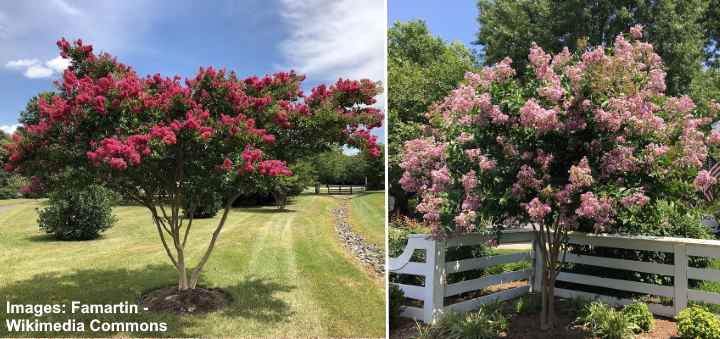
Crape myrtle shrub-like trees have multiple stems
Crape myrtle trees are stunning colorful flowering trees that bloom throughout the summer in Florida. The attractive feature of crape myrtle trees is their vibrantly colored conical flower clusters of red, purple, white, and orange flowers. In addition, the shrub-like trees have rich, dark green leaves that turn red, orange, or yellow in the fall.
Crape myrtle trees are small trees or large shrubs that grow 6 to 10 ft. (1.8 – 3 m) tall and wide. But suppose you have a small, compact garden in Florida. In that case, choose a species of dwarf crape myrtle bushes that grow between 2 and 6 ft. (0.6 – 1.8 m) tall.
Plant the small shrub-like trees in full sun and moist, well-drained soils for best results. The flowering crape myrtle trees are ideal as specimen plants, foundation plantings, or lawn trees.
Related reading: How to care for crape myrtle trees.
Native Florida Tree Identification
Crape myrtle tree has deep green oval leaves growing 2” (5 cm) long, attractive peeling light-brown bark, and clusters of papery flowers in lavender, pink, red, white, and yellow colors.
Jacaranda Tree (Jacaranda mimosifolia)
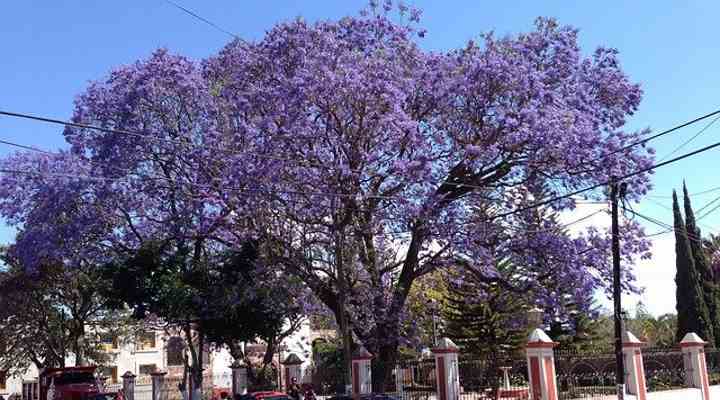
Jacaranda tree (Jacaranda mimosifolia)
The jacaranda tree is a stunning tropical Florida tree with attractive purple blossoms, dark, pinnately compound leaves, and unusually-shaped woody seed pods. The eye-catching tree blossoms with dangling trumpet-shaped lilac flowers that bloom from late spring through August. The fern-like foliage is ideal for dappled shade throughout the year.
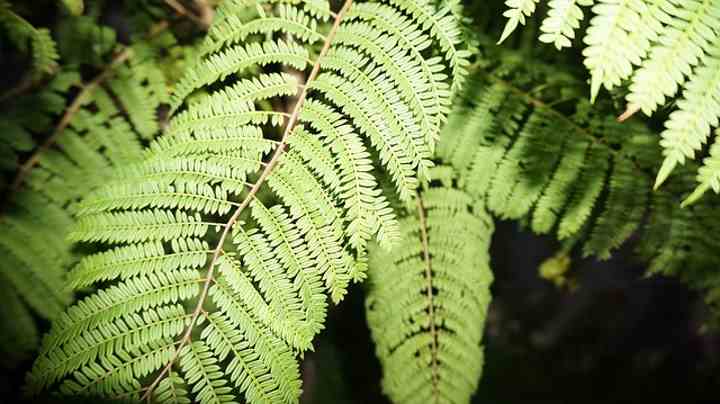
Jacaranda tree leaves
This purple-blue flowering jacaranda tree is common throughout Central and South Florida in USDA zones 9 through 11.
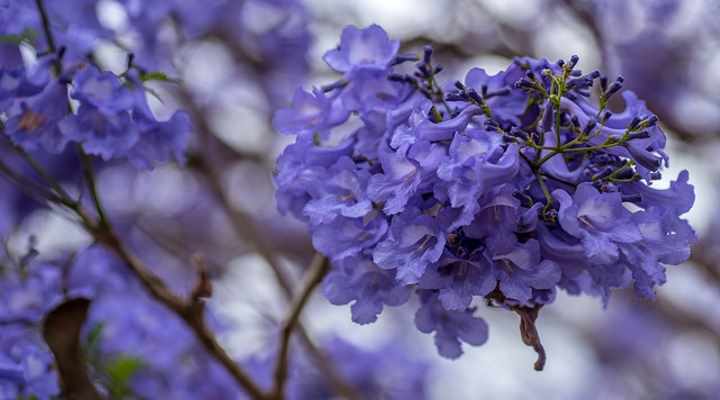
Jacaranda tree flowers
Although the graceful tree is easy to care for, it requires regular pruning to grow as a single-stemmed tree. Also, the tree can be messy when it drops its leaves and pods in late summer and fall. So, it’s not suitable for Florida gardens with swimming pools.

Jacaranda tree fruit (seed pods)
Native Florida Tree Identification
The stunning jacaranda tree is easy to identify due to its attractive funnel-shaped purple blossoms, broad crown covered in feathery foliage, and long blooming time throughout the summer. The large, spreading tree grows 25 to 40 ft. (6 – 12 m) tall and 40 to 60 ft. (12 – 18 m) wide.
Royal Poinciana (Delonix regia)
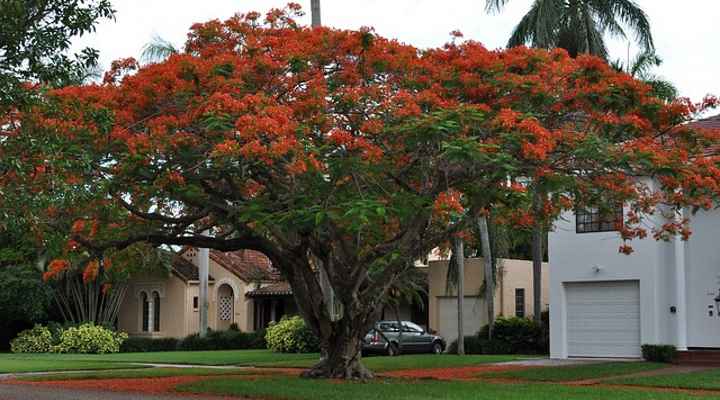
Royal poinciana is also called the flamboyant tree or flame tree
Also called a flame tree due to its bright red flowers, the royal poinciana is a popular shade tree throughout Southern Florida. The striking feature of the tree is its spreading branches and vibrantly-colored showy flowers. Each fragrant flower has four spoon-shaped petals 3” (7.5 cm) long.
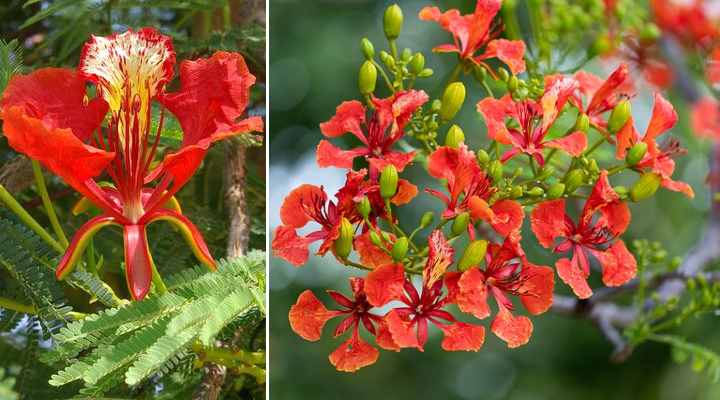
Royal poinciana flowers
Although not native to Florida, the tropical flowering tree has adapted well to the tropical climate of the southeast. The tree thrives in full sunshine, and mature trees grow up to 40 ft. (12 m) tall and 60 ft. (18 m) wide. The royal poinciana tree is characterized by its umbrella-shaped canopy.
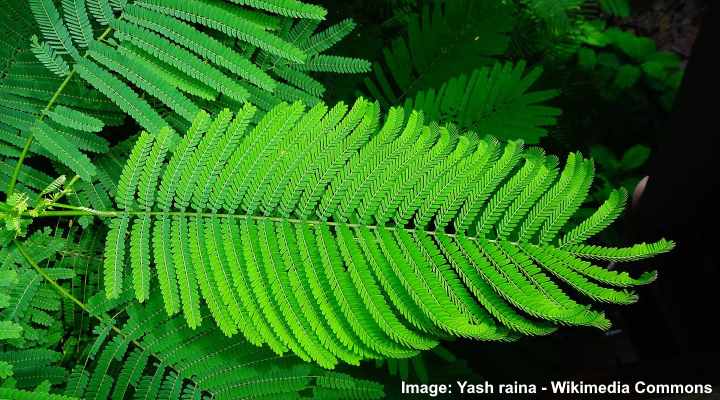
Royal poinciana leaves
Native Florida Tree Identification
The royal poinciana tree is identified by its vibrant orange-red flowers covering the rounded canopy throughout summer. In addition, the shade tree has attractive fern-like foliage that complements the tropical red flowers.
Saucer Magnolia Tree (Magnolia x soulangeana)
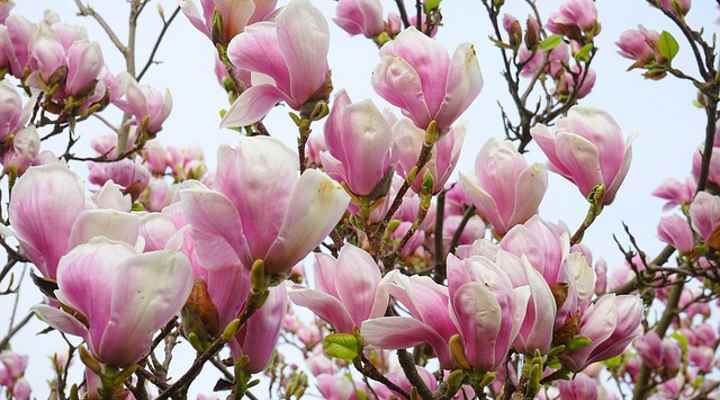
Saucer magnolia tree has a rounded, spreading crown and showy large flowers
The saucer magnolia tree is a stunning ornamental tree that thrives in North and North Central Florida. The showy, fragrant cup-shaped flowers bloom in shades of purple, pink or white. The large 4” to 12” (10 – 30 cm) blossoms appear on this early-blooming tree in late winter before new growth appears.
The characteristics of the saucer magnolia are:
- its upward-facing flowers
- dark green oval-shaped leaves
- golden yellow or coppery-brown fall foliage
Because the saucer magnolia tree is a relatively compact, small tree, it’s a popular choice for landscaping projects in small gardens.
The saucer magnolia reaches 20 ft. (6 m) high by 30 feet (9 m) wide. As the shrub-like tree grows, its initial upright, erect habit becomes more rounded, growing as a multi-stemmed shrub.
Related reading: How to care for magnolia trees.
Native Florida Tree Identification
The saucer magnolia tree is identified by its large cup-shaped blossoms in shades of pink and white, glossy dark-green oval leaves, and smooth silvery bark.
Related: The Best Magnolia Trees to Grow in Florida
Eastern Redbud Tree (Cercis canadensis)
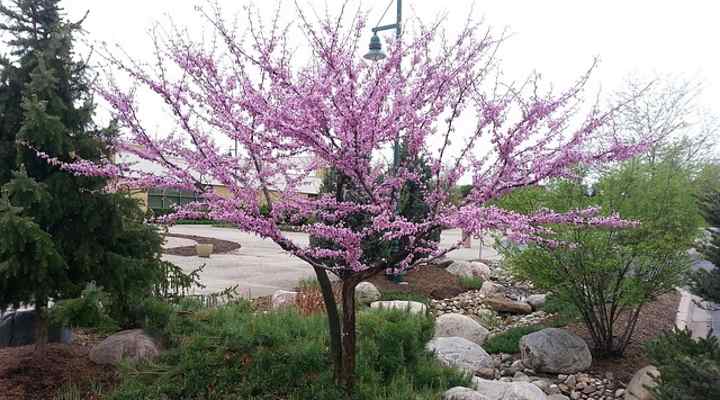
Eastern redbud flowers come in various shades of pink color and are suitable for Northern and upper Central Florida
The eastern redbud tree is a small deciduous native Florida tree. The Eastern redbud tree is famous for its fragrant dark magenta pink flowers growing in clusters on crooked branches. Native to the eastern United States, the redbud tree has reddish-brown bark, heart-shaped leaves 2” to 5” (5 – 13 cm) long, and long rose-colored seed pods.
Eastern redbud trees are suitable for growing in North Florida in USDA zones 8 and 9. Planting it in full sun provides the best flowering results with masses of pea-like rosy-pink blossoms covering the branches. The tree has pale yellow fall colors when they drop, revealing the attractive zigzag branching.
Grow an eastern redbud tree as a specimen tree in full sun and moist soil that drains well.
Native Florida Tree Identification
The eastern redbud tree is known for its showy, fragrant, red-purple flowers in spring emerging from red buds. The attractive pink-flowering tree blooms for several weeks.
Related articles:
